LINCOLN MKT 2018 Owners Manual
Manufacturer: LINCOLN, Model Year: 2018, Model line: MKT, Model: LINCOLN MKT 2018Pages: 564, PDF Size: 4.66 MB
Page 131 of 564
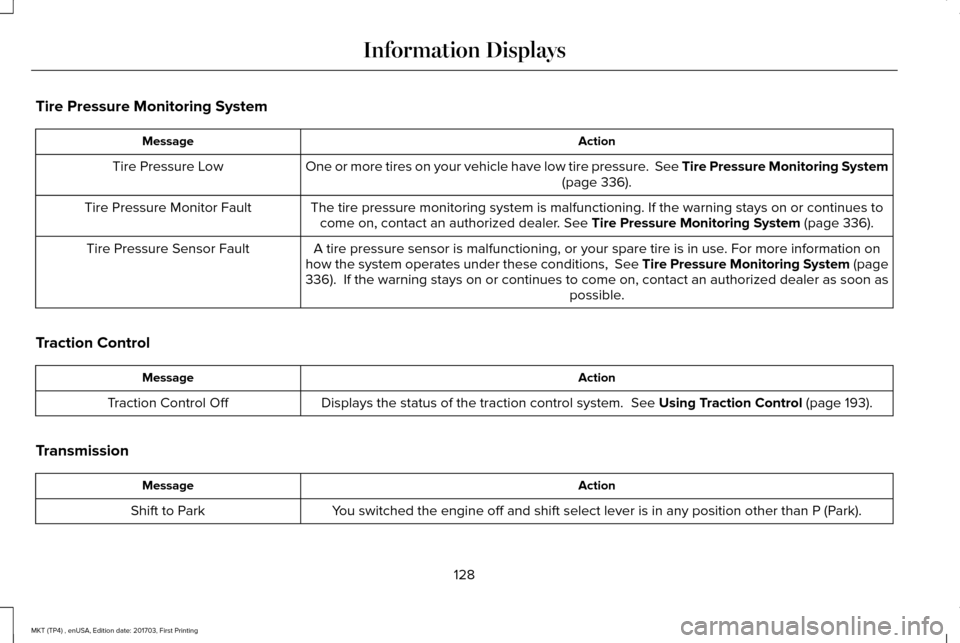
Tire Pressure Monitoring System
Action
Message
One or more tires on your vehicle have low tire pressure. See Tire Pressure Monitoring System (page 336).
Tire Pressure Low
The tire pressure monitoring system is malfunctioning. If the warning st\
ays on or continues tocome on, contact an authorized dealer.
See Tire Pressure Monitoring System (page 336).
Tire Pressure Monitor Fault
A tire pressure sensor is malfunctioning, or your spare tire is in use. For more information on
how the system operates under these conditions, See Tire Pressure Monitoring System (page
336
). If the warning stays on or continues to come on, contact an authorized \
dealer as soon as possible.
Tire Pressure Sensor Fault
Traction Control Action
Message
Displays the status of the traction control system.
See Using Traction Control (page 193).
Traction Control Off
Transmission Action
Message
You switched the engine off and shift select lever is in any position oth\
er than P (Park).
Shift to Park
128
MKT (TP4) , enUSA, Edition date: 201703, First Printing Information Displays
Page 132 of 564
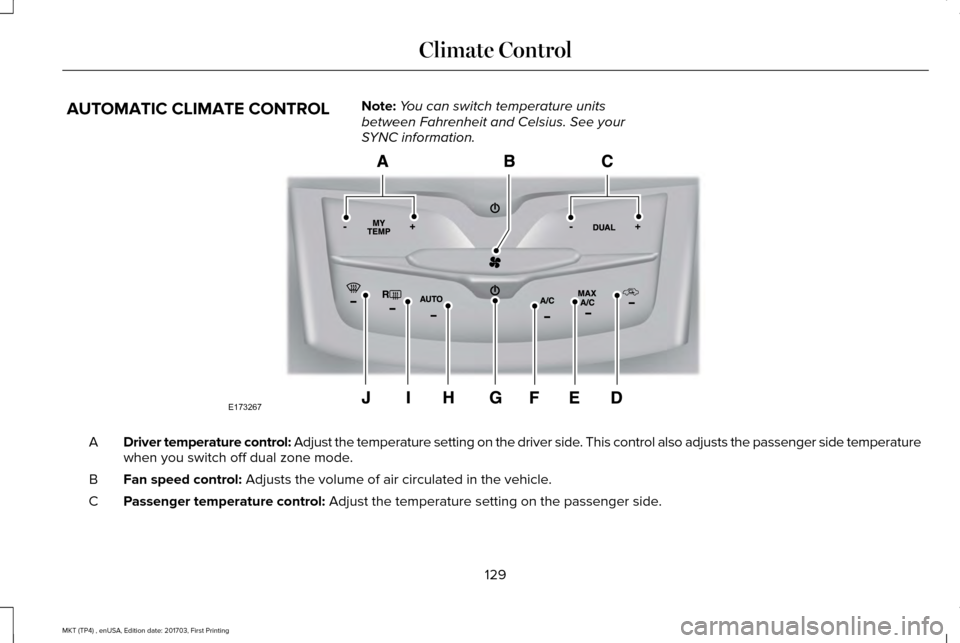
AUTOMATIC CLIMATE CONTROL
Note:
You can switch temperature units
between Fahrenheit and Celsius. See your
SYNC information. Driver temperature control: Adjust the temperature setting on the driver side. This control also adjusts the passenger side temperature
when you switch off dual zone mode.
A
Fan speed control: Adjusts the volume of air circulated in the vehicle.
B
Passenger temperature control:
Adjust the temperature setting on the passenger side.
C
129
MKT (TP4) , enUSA, Edition date: 201703, First Printing Climate ControlE173267
Page 133 of 564
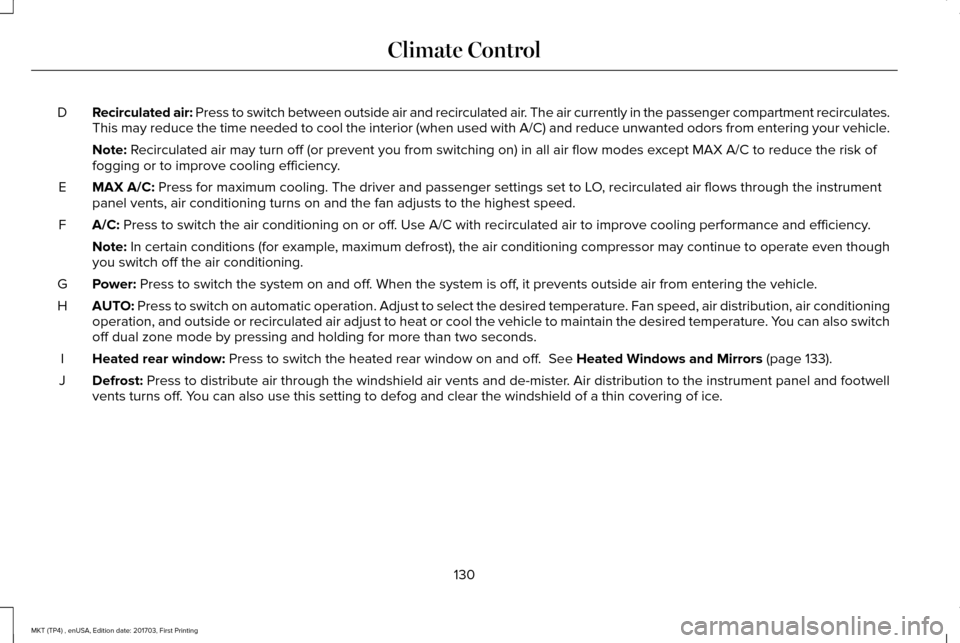
Recirculated air: Press to switch between outside air and recirculated air. The air currently in the passenger compartment recirculates.
This may reduce the time needed to cool the interior (when used with A/\
C) and reduce unwanted odors from entering your vehicle.
D
Note: Recirculated air may turn off (or prevent you from switching on) in all\
air flow modes except MAX A/C to reduce the risk of
fogging or to improve cooling efficiency.
MAX A/C:
Press for maximum cooling. The driver and passenger settings set to LO, recirculated air flows through the instrument
panel vents, air conditioning turns on and the fan adjusts to the highes\
t speed.
E
A/C:
Press to switch the air conditioning on or off. Use A/C with recirculated air to improve cooling performance and effic\
iency.
F
Note:
In certain conditions (for example, maximum defrost), the air conditioning compressor may continue to ope\
rate even though
you switch off the air conditioning.
Power:
Press to switch the system on and off. When the system is off, it prevents outside air from entering the vehicle.
G
AUTO:
Press to switch on automatic operation. Adjust to select the desired te\
mperature. Fan speed, air distribution, air conditioning
operation, and outside or recirculated air adjust to heat or cool the ve\
hicle to maintain the desired temperature. You can also switch
off dual zone mode by pressing and holding for more than two seconds.
H
Heated rear window:
Press to switch the heated rear window on and off. See Heated Windows and Mirrors (page 133).
I
Defrost:
Press to distribute air through the windshield air vents and de-mister. Air distribution to the instrument panel and footwell
vents turns off. You can also use this setting to defog and clear the windshield of a thin\
covering of ice.
J
130
MKT (TP4) , enUSA, Edition date: 201703, First Printing Climate Control
Page 134 of 564
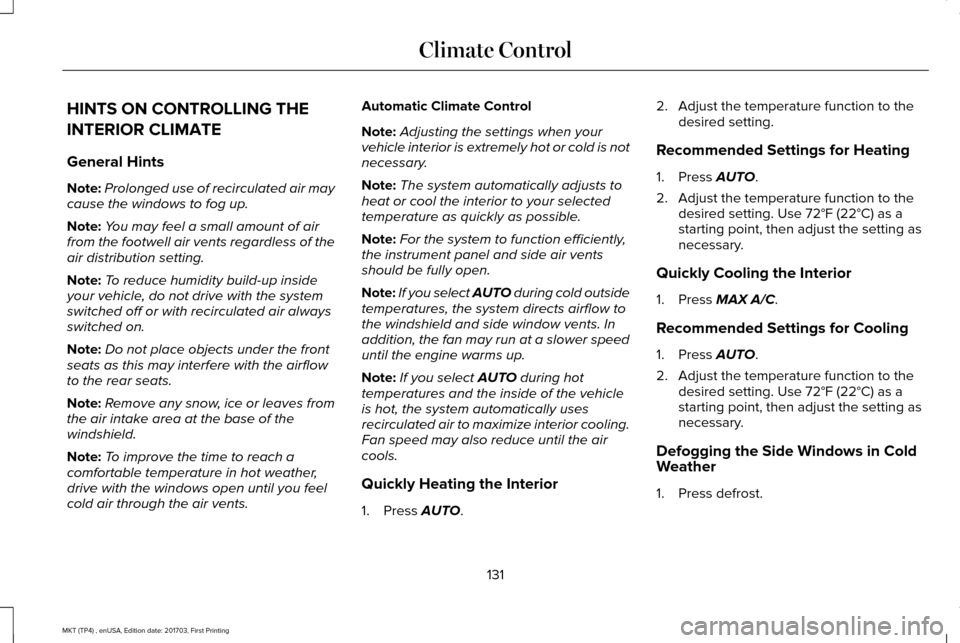
HINTS ON CONTROLLING THE
INTERIOR CLIMATE
General Hints
Note:
Prolonged use of recirculated air may
cause the windows to fog up.
Note: You may feel a small amount of air
from the footwell air vents regardless of the
air distribution setting.
Note: To reduce humidity build-up inside
your vehicle, do not drive with the system
switched off or with recirculated air always
switched on.
Note: Do not place objects under the front
seats as this may interfere with the airflow
to the rear seats.
Note: Remove any snow, ice or leaves from
the air intake area at the base of the
windshield.
Note: To improve the time to reach a
comfortable temperature in hot weather,
drive with the windows open until you feel
cold air through the air vents. Automatic Climate Control
Note:
Adjusting the settings when your
vehicle interior is extremely hot or cold is not
necessary.
Note: The system automatically adjusts to
heat or cool the interior to your selected
temperature as quickly as possible.
Note: For the system to function efficiently,
the instrument panel and side air vents
should be fully open.
Note: If you select AUTO during cold outside
temperatures, the system directs airflow to
the windshield and side window vents. In
addition, the fan may run at a slower speed
until the engine warms up.
Note: If you select
AUTO during hot
temperatures and the inside of the vehicle
is hot, the system automatically uses
recirculated air to maximize interior cooling.
Fan speed may also reduce until the air
cools.
Quickly Heating the Interior
1. Press
AUTO. 2. Adjust the temperature function to the
desired setting.
Recommended Settings for Heating
1. Press
AUTO.
2. Adjust the temperature function to the desired setting. Use
72°F (22°C) as a
starting point, then adjust the setting as
necessary.
Quickly Cooling the Interior
1. Press
MAX A/C.
Recommended Settings for Cooling
1. Press
AUTO.
2. Adjust the temperature function to the desired setting. Use
72°F (22°C) as a
starting point, then adjust the setting as
necessary.
Defogging the Side Windows in Cold
Weather
1. Press defrost.
131
MKT (TP4) , enUSA, Edition date: 201703, First Printing Climate Control
Page 135 of 564
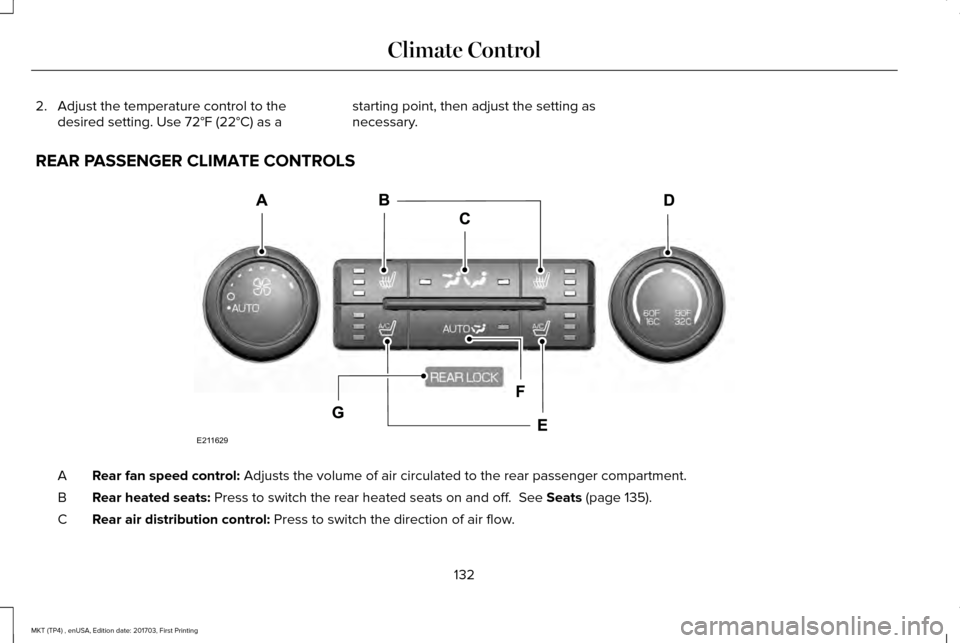
2. Adjust the temperature control to the
desired setting. Use 72°F (22°C) as a starting point, then adjust the setting as
necessary.
REAR PASSENGER CLIMATE CONTROLS Rear fan speed control:
Adjusts the volume of air circulated to the rear passenger compartment.\
A
Rear heated seats:
Press to switch the rear heated seats on and off. See Seats (page 135).
B
Rear air distribution control:
Press to switch the direction of air flow.
C
132
MKT (TP4) , enUSA, Edition date: 201703, First Printing Climate ControlE211629
Page 136 of 564
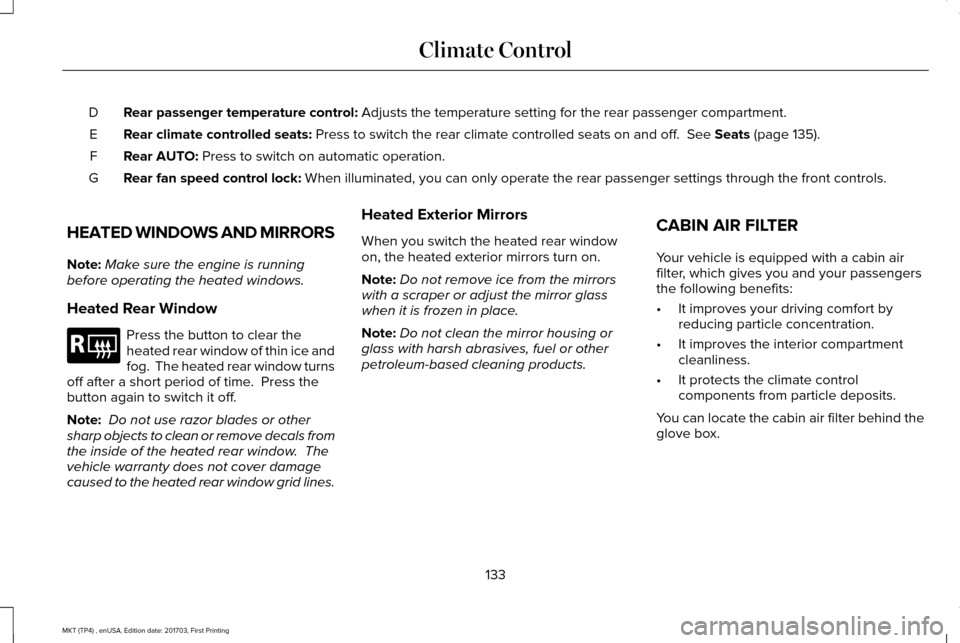
Rear passenger temperature control: Adjusts the temperature setting for the rear passenger compartment.
D
Rear climate controlled seats:
Press to switch the rear climate controlled seats on and off. See Seats (page 135).
E
Rear AUTO:
Press to switch on automatic operation.
F
Rear fan speed control lock:
When illuminated, you can only operate the rear passenger settings thro\
ugh the front controls.
G
HEATED WINDOWS AND MIRRORS
Note: Make sure the engine is running
before operating the heated windows.
Heated Rear Window Press the button to clear the
heated rear window of thin ice and
fog. The heated rear window turns
off after a short period of time. Press the
button again to switch it off.
Note: Do not use razor blades or other
sharp objects to clean or remove decals from
the inside of the heated rear window. The
vehicle warranty does not cover damage
caused to the heated rear window grid lines. Heated Exterior Mirrors
When you switch the heated rear window
on, the heated exterior mirrors turn on.
Note:
Do not remove ice from the mirrors
with a scraper or adjust the mirror glass
when it is frozen in place.
Note: Do not clean the mirror housing or
glass with harsh abrasives, fuel or other
petroleum-based cleaning products. CABIN AIR FILTER
Your vehicle is equipped with a cabin air
filter, which gives you and your passengers
the following benefits:
•
It improves your driving comfort by
reducing particle concentration.
• It improves the interior compartment
cleanliness.
• It protects the climate control
components from particle deposits.
You can locate the cabin air filter behind the
glove box.
133
MKT (TP4) , enUSA, Edition date: 201703, First Printing Climate ControlE184884
Page 137 of 564

Note:
Make sure you have a cabin air filter
installed at all times. This prevents foreign
objects from entering the system. Running
the system without a filter in place could
result in degradation or damage to the
system.
Replace the filter at regular intervals. See
Scheduled Maintenance (page 483).
For additional cabin air filter information, or
to replace the filter, see an authorized dealer.
REMOTE START
You can switch this feature on or off and
adjust the settings using the information
display.
The system adjusts the interior temperature
depending on your chosen settings during
remote start.
You cannot adjust the climate control setting
during remote start operation. When you
switch the ignition on, the climate control
system returns to the previous settings. You
can now make adjustments. You need to switch on certain
vehicle-dependent features, such as:
•
Heated seats.
• Cooled seats.
• Heated steering wheel.
• Heated mirrors.
• Heated rear window.
Automatic Settings
In hot weather, the system sets to
72°F
(22°C). The cooled seats are set to high (if
available, and AUTO is on in the information
display).
In moderate weather, the system either heats
or cools (based on previous settings). The
rear defroster, heated mirrors and heated or
cooled seats do not turn on.
In cold weather, the system sets to
72°F
(22°C). The heated seats are set to high (if
available, and AUTO is on in the information
display). The heated rear window and heated
mirrors turn on.
134
MKT (TP4) , enUSA, Edition date: 201703, First Printing Climate Control
Page 138 of 564
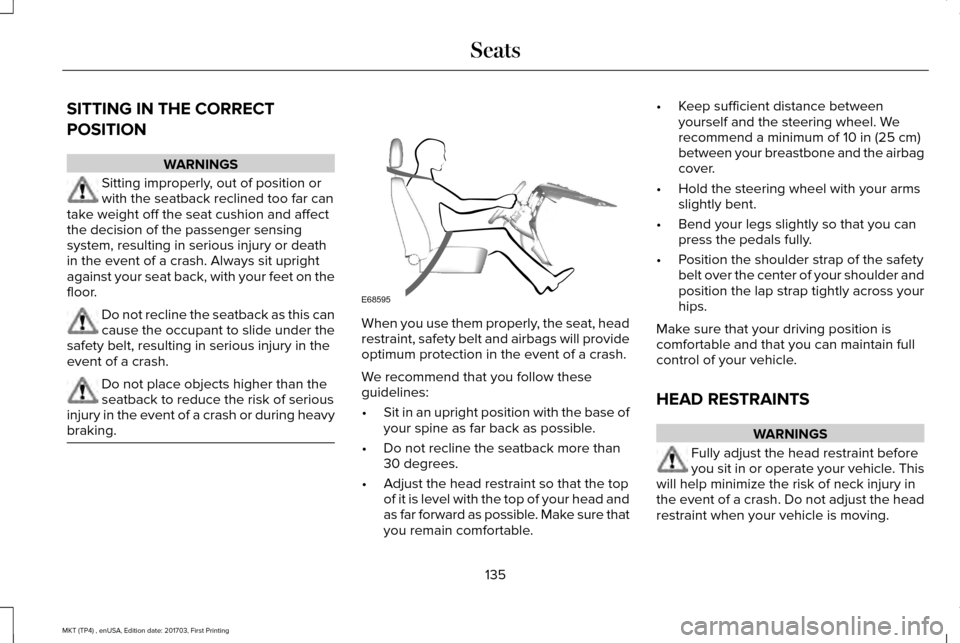
SITTING IN THE CORRECT
POSITION
WARNINGS
Sitting improperly, out of position or
with the seatback reclined too far can
take weight off the seat cushion and affect
the decision of the passenger sensing
system, resulting in serious injury or death
in the event of a crash. Always sit upright
against your seat back, with your feet on the
floor. Do not recline the seatback as this can
cause the occupant to slide under the
safety belt, resulting in serious injury in the
event of a crash. Do not place objects higher than the
seatback to reduce the risk of serious
injury in the event of a crash or during heavy
braking. When you use them properly, the seat, head
restraint, safety belt and airbags will provide
optimum protection in the event of a crash.
We recommend that you follow these
guidelines:
•
Sit in an upright position with the base of
your spine as far back as possible.
• Do not recline the seatback more than
30 degrees.
• Adjust the head restraint so that the top
of it is level with the top of your head and
as far forward as possible. Make sure that
you remain comfortable. •
Keep sufficient distance between
yourself and the steering wheel. We
recommend a minimum of 10 in (25 cm)
between your breastbone and the airbag
cover.
• Hold the steering wheel with your arms
slightly bent.
• Bend your legs slightly so that you can
press the pedals fully.
• Position the shoulder strap of the safety
belt over the center of your shoulder and
position the lap strap tightly across your
hips.
Make sure that your driving position is
comfortable and that you can maintain full
control of your vehicle.
HEAD RESTRAINTS WARNINGS
Fully adjust the head restraint before
you sit in or operate your vehicle. This
will help minimize the risk of neck injury in
the event of a crash. Do not adjust the head
restraint when your vehicle is moving.
135
MKT (TP4) , enUSA, Edition date: 201703, First Printing SeatsE68595
Page 139 of 564

WARNINGS
The head restraint is a safety device.
Whenever possible it should be
installed and properly adjusted when the
seat is occupied. An improperly adjusted
head restraint may provide reduced
protection to an occupant during certain rear
impacts Install the head restraint properly to
help minimize the risk of neck injury in
the event of a crash. Note:
Adjust the seatback to an upright
driving position before adjusting the head
restraint. Adjust the head restraint so that
the top of it is level with the top of your head
and as far forward as possible. Make sure
that you remain comfortable. If you are
extremely tall, adjust the head restraint to
its highest position. Front seat head restraints
Second-row center seat head restraint (If
equipped) The head restraints consist of:
An energy absorbing head
restraint.
A
Two steel stems.
B
Guide sleeve adjust and release
button.
C
Guide sleeve unlock and remove
button.
D
Adjusting the Head Restraint
Raising the Head Restraint
Pull the head restraint up.
Lowering the Head Restraint
1. Press and hold button C.
2. Push the head restraint down.
Removing the Head Restraint
1. Pull the head restraint up until it reaches
its highest position.
2. Press and hold buttons C and D.
3. Pull the head restraint up.
136
MKT (TP4) , enUSA, Edition date: 201703, First Printing SeatsE138642 E138645
Page 140 of 564

Installing the Head Restraint
Align the steel stems into the guide sleeves
and push the head restraint down until it
locks.
Second-row outboard seat head restraints
The head restraints consist of:
An energy absorbing head
restraint.
A
Two steel stems.
B
Guide sleeve unlock and remove
buttons.
C The outboard head restraints are
non-adjustable, but they can be removed.
Removing the Head Restraint
1.
Pull the head restraint up until it reaches
its highest position.
2. Press and hold the C buttons.
3. Pull the head restraint up.
Installing the Head Restraint
Align the steel stems into the guide sleeves
and push the head restraint down until it
locks.
Third-row head restraints (if equipped) The head restraints consist of:
An energy absorbing head
restraint.
A
Two steel stems.
B
Fold strap.
C
Folding the Head Restraint
Pull the fold strap (C). Pull the head restraint
back up to reset.
Note: Press the stow or fold button on the
power folding seats to automatically fold the
head restraint.
Tilting Head Restraints (If Equipped)
The front head restraints tilt for extra comfort.
To tilt the head restraint, do the following:
137
MKT (TP4) , enUSA, Edition date: 201703, First Printing SeatsE162872
A
C
B E190836